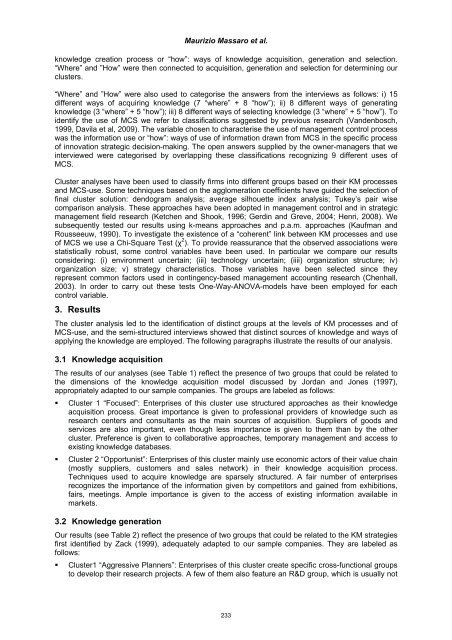Proceedings of the 3rd European Conference on Intellectual Capital
Proceedings of the 3rd European Conference on Intellectual Capital
Proceedings of the 3rd European Conference on Intellectual Capital
You also want an ePaper? Increase the reach of your titles
YUMPU automatically turns print PDFs into web optimized ePapers that Google loves.
Maurizio Massaro et al.<br />
knowledge creati<strong>on</strong> process or “how”: ways <str<strong>on</strong>g>of</str<strong>on</strong>g> knowledge acquisiti<strong>on</strong>, generati<strong>on</strong> and selecti<strong>on</strong>.<br />
“Where” and ”How” were <str<strong>on</strong>g>the</str<strong>on</strong>g>n c<strong>on</strong>nected to acquisiti<strong>on</strong>, generati<strong>on</strong> and selecti<strong>on</strong> for determining our<br />
clusters.<br />
“Where” and ”How” were also used to categorise <str<strong>on</strong>g>the</str<strong>on</strong>g> answers from <str<strong>on</strong>g>the</str<strong>on</strong>g> interviews as follows: i) 15<br />
different ways <str<strong>on</strong>g>of</str<strong>on</strong>g> acquiring knowledge (7 “where” + 8 “how”); ii) 8 different ways <str<strong>on</strong>g>of</str<strong>on</strong>g> generating<br />
knowledge (3 “where” + 5 “how”); iii) 8 different ways <str<strong>on</strong>g>of</str<strong>on</strong>g> selecting knowledge (3 “where” + 5 “how”). To<br />
identify <str<strong>on</strong>g>the</str<strong>on</strong>g> use <str<strong>on</strong>g>of</str<strong>on</strong>g> MCS we refer to classificati<strong>on</strong>s suggested by previous research (Vandenbosch,<br />
1999, Davila et al, 2009). The variable chosen to characterise <str<strong>on</strong>g>the</str<strong>on</strong>g> use <str<strong>on</strong>g>of</str<strong>on</strong>g> management c<strong>on</strong>trol process<br />
was <str<strong>on</strong>g>the</str<strong>on</strong>g> informati<strong>on</strong> use or “how”: ways <str<strong>on</strong>g>of</str<strong>on</strong>g> use <str<strong>on</strong>g>of</str<strong>on</strong>g> informati<strong>on</strong> drawn from MCS in <str<strong>on</strong>g>the</str<strong>on</strong>g> specific process<br />
<str<strong>on</strong>g>of</str<strong>on</strong>g> innovati<strong>on</strong> strategic decisi<strong>on</strong>-making. The open answers supplied by <str<strong>on</strong>g>the</str<strong>on</strong>g> owner-managers that we<br />
interviewed were categorised by overlapping <str<strong>on</strong>g>the</str<strong>on</strong>g>se classificati<strong>on</strong>s recognizing 9 different uses <str<strong>on</strong>g>of</str<strong>on</strong>g><br />
MCS.<br />
Cluster analyses have been used to classify firms into different groups based <strong>on</strong> <str<strong>on</strong>g>the</str<strong>on</strong>g>ir KM processes<br />
and MCS-use. Some techniques based <strong>on</strong> <str<strong>on</strong>g>the</str<strong>on</strong>g> agglomerati<strong>on</strong> coefficients have guided <str<strong>on</strong>g>the</str<strong>on</strong>g> selecti<strong>on</strong> <str<strong>on</strong>g>of</str<strong>on</strong>g><br />
final cluster soluti<strong>on</strong>: dendogram analysis; average silhouette index analysis; Tukey’s pair wise<br />
comparis<strong>on</strong> analysis. These approaches have been adopted in management c<strong>on</strong>trol and in strategic<br />
management field research (Ketchen and Shook, 1996; Gerdin and Greve, 2004; Henri, 2008). We<br />
subsequently tested our results using k-means approaches and p.a.m. approaches (Kaufman and<br />
Rousseeuw, 1990). To investigate <str<strong>on</strong>g>the</str<strong>on</strong>g> existence <str<strong>on</strong>g>of</str<strong>on</strong>g> a “coherent” link between KM processes and use<br />
<str<strong>on</strong>g>of</str<strong>on</strong>g> MCS we use a Chi-Square Test (χ 2 ). To provide reassurance that <str<strong>on</strong>g>the</str<strong>on</strong>g> observed associati<strong>on</strong>s were<br />
statistically robust, some c<strong>on</strong>trol variables have been used. In particular we compare our results<br />
c<strong>on</strong>sidering: (i) envir<strong>on</strong>ment uncertain; (iii) technology uncertain; (iiii) organizati<strong>on</strong> structure; iv)<br />
organizati<strong>on</strong> size; v) strategy characteristics. Those variables have been selected since <str<strong>on</strong>g>the</str<strong>on</strong>g>y<br />
represent comm<strong>on</strong> factors used in c<strong>on</strong>tingency-based management accounting research (Chenhall,<br />
2003). In order to carry out <str<strong>on</strong>g>the</str<strong>on</strong>g>se tests One-Way-ANOVA-models have been employed for each<br />
c<strong>on</strong>trol variable.<br />
3. Results<br />
The cluster analysis led to <str<strong>on</strong>g>the</str<strong>on</strong>g> identificati<strong>on</strong> <str<strong>on</strong>g>of</str<strong>on</strong>g> distinct groups at <str<strong>on</strong>g>the</str<strong>on</strong>g> levels <str<strong>on</strong>g>of</str<strong>on</strong>g> KM processes and <str<strong>on</strong>g>of</str<strong>on</strong>g><br />
MCS-use, and <str<strong>on</strong>g>the</str<strong>on</strong>g> semi-structured interviews showed that distinct sources <str<strong>on</strong>g>of</str<strong>on</strong>g> knowledge and ways <str<strong>on</strong>g>of</str<strong>on</strong>g><br />
applying <str<strong>on</strong>g>the</str<strong>on</strong>g> knowledge are employed. The following paragraphs illustrate <str<strong>on</strong>g>the</str<strong>on</strong>g> results <str<strong>on</strong>g>of</str<strong>on</strong>g> our analysis.<br />
3.1 Knowledge acquisiti<strong>on</strong><br />
The results <str<strong>on</strong>g>of</str<strong>on</strong>g> our analyses (see Table 1) reflect <str<strong>on</strong>g>the</str<strong>on</strong>g> presence <str<strong>on</strong>g>of</str<strong>on</strong>g> two groups that could be related to<br />
<str<strong>on</strong>g>the</str<strong>on</strong>g> dimensi<strong>on</strong>s <str<strong>on</strong>g>of</str<strong>on</strong>g> <str<strong>on</strong>g>the</str<strong>on</strong>g> knowledge acquisiti<strong>on</strong> model discussed by Jordan and J<strong>on</strong>es (1997),<br />
appropriately adapted to our sample companies. The groups are labeled as follows:<br />
Cluster 1 “Focused”: Enterprises <str<strong>on</strong>g>of</str<strong>on</strong>g> this cluster use structured approaches as <str<strong>on</strong>g>the</str<strong>on</strong>g>ir knowledge<br />
acquisiti<strong>on</strong> process. Great importance is given to pr<str<strong>on</strong>g>of</str<strong>on</strong>g>essi<strong>on</strong>al providers <str<strong>on</strong>g>of</str<strong>on</strong>g> knowledge such as<br />
research centers and c<strong>on</strong>sultants as <str<strong>on</strong>g>the</str<strong>on</strong>g> main sources <str<strong>on</strong>g>of</str<strong>on</strong>g> acquisiti<strong>on</strong>. Suppliers <str<strong>on</strong>g>of</str<strong>on</strong>g> goods and<br />
services are also important, even though less importance is given to <str<strong>on</strong>g>the</str<strong>on</strong>g>m than by <str<strong>on</strong>g>the</str<strong>on</strong>g> o<str<strong>on</strong>g>the</str<strong>on</strong>g>r<br />
cluster. Preference is given to collaborative approaches, temporary management and access to<br />
existing knowledge databases.<br />
Cluster 2 “Opportunist”: Enterprises <str<strong>on</strong>g>of</str<strong>on</strong>g> this cluster mainly use ec<strong>on</strong>omic actors <str<strong>on</strong>g>of</str<strong>on</strong>g> <str<strong>on</strong>g>the</str<strong>on</strong>g>ir value chain<br />
(mostly suppliers, customers and sales network) in <str<strong>on</strong>g>the</str<strong>on</strong>g>ir knowledge acquisiti<strong>on</strong> process.<br />
Techniques used to acquire knowledge are sparsely structured. A fair number <str<strong>on</strong>g>of</str<strong>on</strong>g> enterprises<br />
recognizes <str<strong>on</strong>g>the</str<strong>on</strong>g> importance <str<strong>on</strong>g>of</str<strong>on</strong>g> <str<strong>on</strong>g>the</str<strong>on</strong>g> informati<strong>on</strong> given by competitors and gained from exhibiti<strong>on</strong>s,<br />
fairs, meetings. Ample importance is given to <str<strong>on</strong>g>the</str<strong>on</strong>g> access <str<strong>on</strong>g>of</str<strong>on</strong>g> existing informati<strong>on</strong> available in<br />
markets.<br />
3.2 Knowledge generati<strong>on</strong><br />
Our results (see Table 2) reflect <str<strong>on</strong>g>the</str<strong>on</strong>g> presence <str<strong>on</strong>g>of</str<strong>on</strong>g> two groups that could be related to <str<strong>on</strong>g>the</str<strong>on</strong>g> KM strategies<br />
first identified by Zack (1999), adequately adapted to our sample companies. They are labeled as<br />
follows:<br />
Cluster1 “Aggressive Planners”: Enterprises <str<strong>on</strong>g>of</str<strong>on</strong>g> this cluster create specific cross-functi<strong>on</strong>al groups<br />
to develop <str<strong>on</strong>g>the</str<strong>on</strong>g>ir research projects. A few <str<strong>on</strong>g>of</str<strong>on</strong>g> <str<strong>on</strong>g>the</str<strong>on</strong>g>m also feature an R&D group, which is usually not<br />
233
















